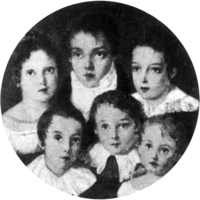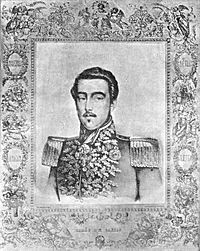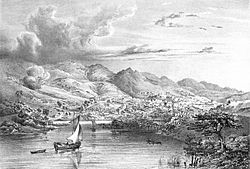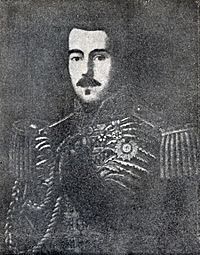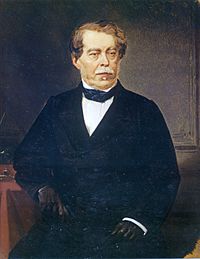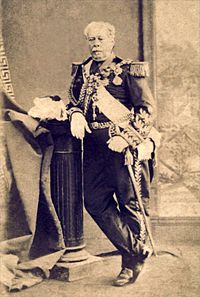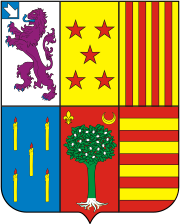Luís Alves de Lima e Silva, Duke of Caxias facts for kids
Quick facts for kids
The Duke of Caxias
|
|
|---|---|
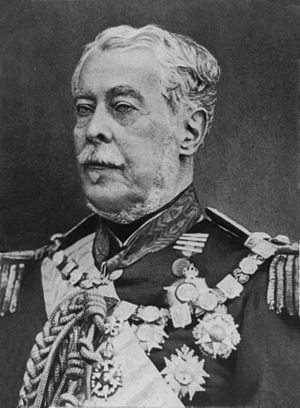
Caxias in 1878
|
|
| Prime Minister of Brazil | |
| In office 25 June 1875 – 5 January 1878 |
|
| Monarch | Pedro II |
| Preceded by | Viscount of Rio Branco |
| Succeeded by | Viscount of Sinimbu |
| In office 2 March 1861 – 24 May 1862 |
|
| Monarch | Pedro II |
| Preceded by | Baron of Uruguaiana |
| Succeeded by | Zacarias de Góis |
| In office 3 September 1856 – 3 May 1857 |
|
| Monarch | Pedro II |
| Preceded by | Marquis of Paraná |
| Succeeded by | Marquis of Olinda |
| President of the Rio Grande do Sul Province | |
| In office 30 June 1851 – 4 September 1851 |
|
| Preceded by | Pedro Ferreira de Oliveira |
| Succeeded by | Patrício José Correia da Câmara |
| In office 9 November 1842 – 11 March 1846 |
|
| Preceded by | Saturnino de Sousa e Oliveira Coutinho |
| Succeeded by | Patrício José Correia da Câmara |
| President of the Maranhão Province | |
| In office 17 February 1840 – 13 May 1841 |
|
| Preceded by | Manuel Felizardo de Sousa e Melo |
| Succeeded by | João Antônio de Miranda |
| Personal details | |
| Born |
Luís Alves de Lima e Silva
25 August 1803 São Paulo Farm, (now Duque de Caxias, Rio de Janeiro), State of Brazil, Portuguese America |
| Died | 7 May 1880 (aged 76) Santa Mônica Farm, (now Valença, Rio de Janeiro), Empire of Brazil |
| Political party | Conservative (from 1843) |
| Occupation | Politician |
| Awards | See list |
| Signature | |
| Nicknames |
|
| Military service | |
| Allegiance | |
| Branch/service | Imperial Brazilian Army |
| Years of service | 1821–1880 |
| Rank | Field Marshal |
| Battles/wars |
|
 Coat of Arms of the Duke of Caxias |
|
Luís Alves de Lima e Silva, Duke of Caxias (born August 25, 1803 – died May 7, 1880) was a famous army officer and politician in the Empire of Brazil. He was known by nicknames like "the Peacemaker" and "the Iron Duke." Caxias came from a military family and followed in their footsteps.
He fought in Brazil's War for Independence against Portugal in 1823. Later, he served in the Cisplatine War, where Brazil lost its southernmost province, which became Uruguay. Unlike some of his family, Caxias remained loyal to Emperor Pedro I and later became a friend and teacher to his young son, Pedro II.
During Pedro II's childhood, Brazil faced many rebellions. Caxias led loyal forces to put down these uprisings, including the Balaiada, the Liberal rebellions of 1842, and the Ragamuffin War. In 1851, he led the Brazilian army to victory in the Platine War against Argentina. A decade later, as a top army marshal, Caxias led Brazil to victory in the Paraguayan War. For his achievements, he received many honors, becoming the only person to be named a duke during Pedro II's long reign.
Caxias was also a politician, becoming a senator and serving as Prime Minister three times. He was a key member of the Conservative Party. After his death, his reputation grew, and in 1925, his birthday became "Day of the Soldier" in Brazil. In 1962, he was officially named the protector of the Brazilian army, seen as a model soldier and leader.
Contents
Early Life and Military Training
Birth and Family
Luís Alves de Lima e Silva was born on August 25, 1803, on a farm in Duque de Caxias, Rio de Janeiro. He was the first son of Francisco de Lima e Silva and Mariana Cândido de Oliveira Belo. His family had a strong military background.
His grandfather, José Joaquim, was a Portuguese military officer who moved to Brazil in 1767. He married into an important local family, helping his family rise in society. When the Portuguese Royal Family moved to Brazil in 1808, Luís Alves's relatives, who were military officers, gained more honors and titles. His family went from ordinary people to part of Portugal's lower nobility in just two generations.
Starting His Military Career
Luís Alves joined the 1st Regiment of Infantry of Rio de Janeiro as a cadet when he was just five years old, on May 22, 1808. This was an honorary title because he was the son of a military officer. This regiment was even known as the "Lima family Regiment" because so many family members served there.
In 1811, Luís Alves moved to Rio de Janeiro with his parents and started school. In 1818, he joined the Royal Military Academy. He studied subjects like math, tactics, and strategy. He was promoted to second lieutenant in 1818 and to first lieutenant in 1820. He was a good student, but sometimes got into trouble for teasing new students. As he grew up, he became known as a fair and honest person. He was calm and had a strong sense of authority.
Wars and Challenges
Fighting for Brazil's Independence
In December 1821, Luís Alves left the Royal Military Academy to join the 1st Fusilier Battalion. Prince Dom Pedro was leading Brazil's fight for independence from Portugal. Brazil declared independence on September 7, 1822, and Pedro became Emperor Pedro I.
On January 18, 1823, Pedro I created the Emperor's Battalion, an elite unit that included Luís Alves. He was an adjutant (a military assistant) to his uncle, Colonel José Joaquim de Lima e Silva. The battalion was sent to Bahia to fight Portuguese forces. Luís Alves fought bravely in several successful attacks against the Portuguese. On July 2, the Brazilians won, and the Portuguese left Salvador. Luís Alves was promoted to captain in January 1824.
The Cisplatine War and Pedro I's Abdication
The last Portuguese soldiers in Brazil were in Montevideo, the capital of Cisplatina (Brazil's southernmost province). In 1825, people in Cisplatina rebelled, and Argentina tried to take over the province. This led to the Cisplatine War. Luís Alves's battalion was sent to guard Montevideo, and he fought in several battles against the rebels in 1827.
The war ended badly for Brazil in 1828, as Cisplatina became the independent country of Uruguay. Despite this, Luís Alves was promoted to major in December 1828. He returned to Rio de Janeiro during a time of political unrest. On April 6, 1831, large protests broke out against Emperor Pedro I. Luís Alves's father and uncles joined the rebels.
The Emperor asked Luís Alves which side he would choose. Luís Alves said he would stay loyal to the crown, even over his father. Pedro I thanked him but ordered him to take his battalion to join the rebels, choosing to step down rather than cause bloodshed. Luís Alves later said he followed orders and believed the Emperor's abdication was good for Brazil, but he wasn't part of the rebellion.
A Time of Trouble in Brazil
After Pedro I left, a group of three regents (temporary rulers) was chosen to govern until young Pedro II was old enough to rule. Luís Alves's father was one of these regents. This period was chaotic, with many rebellions and attempts to take power. The army was weakened, and a new militia, the National Guard, was created.
In July 1831, Luís Alves joined the Volunteer Soldier-Officers Battalion. He helped stop a navy mutiny in October. A year later, in October 1832, he became the commander of the Permanent Municipal Guard Corps, a police force in Rio de Janeiro.
On January 6, 1833, at age 29, he married Ana Luísa de Loreto Carneiro Viana, who was 16. Her mother didn't approve, but their marriage was happy, and they had three children: Luísa, Ana, and Luís Alves.
In the late 1830s, Luís Alves became a teacher for the young Emperor Pedro II, teaching him swordsmanship and horsemanship. They became close friends. Pedro II later called Luís Alves "loyal and my friend." Luís Alves was a strong supporter of the Emperor and a united Brazil.
Stopping Rebellions
The Balaiada Rebellion
As commander of the Municipal Guard, Luís Alves helped bring order to Rio de Janeiro. He was promoted to lieutenant colonel in September 1837. In December 1839, he was promoted to colonel and sent to Maranhão province to stop a rebellion called the Balaiada. He was given full control over the province's government and military.
Luís Alves arrived in São Luís in February 1840. After several battles, he defeated the rebels. For this success, he was promoted to brigadier general in July 1841. Emperor Pedro II also gave him the title of Barão de Caxias (Baron of Caxias). He chose this title to honor his recapture of Caxias, an important town that the rebels had taken.
The Liberal Rebellions of 1842
When Caxias returned from Maranhão, the political situation had changed. The Liberal Party, which his father belonged to, had pushed for Emperor Pedro II to be declared old enough to rule sooner than planned, in July 1840. In May 1842, Liberals rebelled in Rio de Janeiro, São Paulo, and Minas Gerais. This was because the Emperor, advised by the Reactionary Party (who were against the Liberals), had called for new elections due to fraud in the previous ones.
Caxias was sent to São Paulo in May 1842 as the province's military commander. He defeated the rebels there, then moved to Minas Gerais. With help from the National Guard, he crushed that rebellion by late August. Pedro II honored Caxias by making him his aide-de-camp (personal assistant) in July 1842. Two days later, Caxias was promoted to acting field marshal.
Around 1843, the Reactionary Party became known as the Party of Order, or saquaremas. Caxias strongly supported their ideas: a strong government and a parliamentary monarchy. His victories against the Liberal rebels in 1842 made his loyalty to the Party of Order even stronger.
The Ragamuffin War
The Ragamuffin War was a republican rebellion that started in Rio Grande do Sul in 1835. Caxias's uncle joined the rebels, and his father secretly supported them. On September 28, 1842, Caxias was appointed governor and military commander of Rio Grande do Sul. The 16-year-old Emperor Pedro II trusted Caxias to end this rebellion, just as he had ended others.
When Caxias arrived in November 1842, the rebels were weak and using guerrilla warfare. They would escape to nearby Uruguay when threatened. Caxias used spies to gather information and cause disagreements among the enemy. He showed great military and organizational skills in stopping the rebellion.
The war took a long time, but Caxias used careful talks and military victories to bring peace to the province. The fighting officially ended on March 1, 1845. He was made a permanent field marshal in March and a count in April. Caxias was later elected senator for Rio Grande do Sul in late 1845.
Political Life and Major Wars
The Platine War

In September 1848, the Party of Order (now known as the Conservative Party) was asked by Pedro II to form a new government. Caxias was a wealthy landowner who owned slaves, and he was a key part of this party. In 1838, he bought his first coffee farm, and he bought more land in 1849. Coffee was Brazil's most important export.
In 1851, the dictator of Argentina, Juan Manuel de Rosas, declared war on Brazil. Caxias was made commander-in-chief of the Brazilian land forces. Brazil formed an alliance with Uruguay and rebel Argentine provinces against Rosas. Caxias suggested his friend Honório Hermeto Carneiro Leão to represent Brazil among the allies.
An army led by Caxias entered Uruguay in September 1851. The allied forces split into two armies. Caxias chose Manuel Marques de Sousa to lead one of the forces. On February 3, 1852, in the Battle of Caseros, the allies defeated Rosas's army, and Rosas fled. Caxias was promoted to lieutenant general in March and became a marquis in June for his role in the victory.
Serving as Prime Minister
Caxias's father died in December 1853. Although they had often disagreed politically, they remained close. By 1855, the Party of Order was widely known as the Conservative Party. In June 1855, Caxias became the Minister of War in a government led by Honório Hermeto (now Marquis of Paraná). Caxias and Paraná had a strong friendship and shared similar views.
Caxias was seen as a military man first, and deeply loyal to the Emperor and the monarchy. He was a good choice for minister because he could please different groups within the party.
In March 1861, the Emperor asked Caxias to lead a new government as Prime Minister. Caxias tried to get support from the older Conservative leaders, but they wanted to control the government through him. Caxias refused to be a "hobbyhorse" for them. Without enough support in parliament, Caxias's government resigned in May 1862.
A month later, Caxias's only son died at age 14. At the end of 1862, Caxias was promoted to army marshal, the highest rank in the Brazilian army.
The Paraguayan War
The Siege of Uruguaiana

In December 1864, the dictator of Paraguay, Francisco Solano López, started the Paraguayan War by invading Brazil. Four months later, Paraguayan troops invaded Argentina to attack Rio Grande do Sul.
The situation in Rio Grande do Sul was chaotic. Emperor Pedro II decided to go to the front lines, and Caxias, as his military aide, went with him. Caxias had warned the government that Brazil was not ready for war, but his warnings were ignored.
The Emperor and Caxias arrived in Rio Grande do Sul in July 1865 and reached Uruguaiana in September. This Brazilian town was occupied by Paraguayans and was under siege by Brazilian, Argentine, and Uruguayan forces. The Paraguayans surrendered without a fight, and the Emperor and Caxias returned to the capital.
Leading the Allied Forces
The allies invaded Paraguay in April 1866, but their advance was stopped by strong forts at Humaitá. The government decided to put all Brazilian forces in Paraguay under one command, and they chose the 63-year-old Caxias in October 1866. He accepted because he believed the war affected everyone, from the Emperor to the poorest slave.
Caxias arrived in Paraguay in November and took command of all land and naval forces. He stopped all attacks for several months to train his soldiers, get new weapons, improve the officers, and make sure the troops were healthy. He ended epidemics that had been spreading.
Once the army was ready, Caxias planned to surround Humaitá and force it to surrender. He even used observation balloons to spy on enemy lines. The allied army surrounded Humaitá. In February 1868, Brazilian ships sailed past the forts on the Paraguay River, cutting off Humaitá from water supplies.
The Dezembrada Victories
Caxias's relationship with the ruling Progressive government became difficult, leading to the government's resignation in July 1868. The Conservatives, Caxias's party, returned to power. Meanwhile, the allies took Humaitá in July after the Paraguayans managed to escape.
Caxias then planned an attack on new Paraguayan defenses along the Pikysyry stream, south of Asunción, Paraguay's capital. This area was very hard to cross. Instead of a direct attack, Caxias had a road built through the swampy jungle. This road was finished in early December, allowing the allied forces to go around the Paraguayan lines and attack from behind.
In three major battles—Ytororó, Avay, and Lomas Valentinas—known as Dezembrada (Deed of December), the allied forces destroyed the Paraguayan army. López barely escaped, and on January 1, 1869, the Brazilians occupied Asunción. Historians say Caxias's leadership was key to winning the war.
Caxias took big risks to win. In the Ytororó battle, Brazilian soldiers panicked and started to run away. Caxias, seeing this, rode his horse toward the bridge, shouting, "Those who are true Brazilians, follow me!" His bravery stopped the retreat. The units regrouped, and Caxias personally led a strong attack that defeated the Paraguayans. Several men near him were killed, and his horse died.
After the War
Caxias was old, sick, and tired when he reached Asunción. He asked to be relieved of his command or to take a short break. His request was denied, but he appointed someone else to lead and left for Brazil on January 19, 1869. The Emperor was angry that Caxias left without permission and declared the war won when López was still at large.
Caxias arrived home in Rio de Janeiro in February, surprising his wife. He later said he would have died like another officer who returned sick if he hadn't left that "hell." Pedro II was disappointed but also knew Caxias was responsible for the great victories, which came at a huge personal cost. The Emperor met with Caxias on February 21, 1869, for a reconciliation.
A few days later, the Emperor gave Caxias the highest title of Brazilian nobility, making him a duke. This was a unique honor during Pedro II's 58-year reign. Caxias was also appointed to the Council of State. Despite this, he faced criticism in parliament. He wrote to a friend that he understood why older people became selfish, because of the "disappointments and ingratitudes they suffer."
Later Years and Death
His Last Government Role
From 1871 to 1875, another Conservative government was in power. It faced two major problems: the Law of Free Birth, which freed children born to enslaved women after the law was passed, and the Religious Issue, where the government clashed with bishops who had expelled Freemasons from church groups. Caxias, who was a Freemason but also a strong Catholic, supported the Law of Free Birth.
The previous government resigned because of these issues. Pedro II asked Caxias to form a new government on June 25, 1875. Caxias, almost 72 and a widower since 1874, was in poor health. He served mostly as a figurehead, with a friend doing most of the work. Caxias threatened to resign if the Emperor didn't pardon the convicted bishops, which Pedro II did in September 1875.
The End of His Life
By the end of 1877, Caxias's health was so bad that Pedro II realized he couldn't stay in office. The entire government resigned on January 1, 1878. Caxias had been asking to resign since early 1876. He felt he no longer had an important role in politics. He belonged to an older generation who believed the Emperor was essential for keeping the nation together.
Newer politicians didn't remember the difficult times before Pedro II took control in 1840. They had only known stable government and wealth. Caxias felt a sense of loss for his old Conservative friends who had passed away. He was pessimistic about the future of politics.
Confined to a wheelchair, the Duke of Caxias spent his last days at Santa Mônica farm, near Valença. He died quietly on May 7, 1880, at 11 pm, surrounded by his family. A sad Pedro II, who had visited Caxias often, said he had known and respected his "friend of almost a half century" since 1832.
Caxias had asked for a simple funeral with no grand ceremony. His wish was not fully followed. Pedro II sent a special carriage used for imperial family funerals, and a large procession followed his body. He was buried in the São Francisco de Paula cemetery in Rio de Janeiro.
Caxias's Legacy
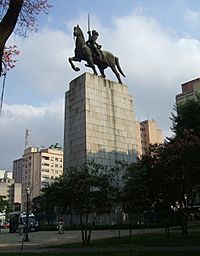
For many years after his death, the Duke of Caxias was not seen as the most important military figure in Brazil. That honor belonged to another general, Manuel Luís Osório, Marquis of Erval. However, Caxias's reputation slowly grew. In 1923, the army created an annual celebration in his honor. In 1925, his birthday, August 25, officially became "Day of the Soldier," celebrating the Brazilian army.
On August 25, 1949, his remains and those of his wife were moved to the Duke of Caxias Pantheon in Rio de Janeiro. On March 13, 1962, Caxias became the official "protector" of the army, making him the most important symbol of its traditions. He is seen as a loyal and dutiful officer, a role model for the Brazilian army. His name, caxias, is even used to describe someone who follows rules strictly and honestly.
Historians generally view Caxias very positively, with many calling him the greatest Brazilian military officer. He is seen as a great military commander and a skilled politician. Some historians say he was "more than D. Pedro II—the Empire," meaning he was crucial to its strength. He is praised for overcoming challenges and making personal sacrifices for his country. Caxias is considered a hero who, despite having some common beliefs of his time, worked hard to achieve his goals.
He was a powerful figure in the Conservative party and Brazil's most successful soldier. He proved his ability and loyalty by stopping revolts against the government. He was genuinely loyal to the Emperor. Historians describe him as "shrewdly competent" as both a statesman and a military man.
Titles and Honors
Titles of Nobility
- Baron of Caxias (July 18, 1841)
- Count of Caxias (March 25, 1845)
- Marquis of Caxias (June 26, 1852)
- Duke of Caxias (March 23, 1869)
Other Important Roles
- Member of the Brazilian Council of State (a group advising the Emperor).
- Member of the Brazilian Historic and Geographic Institute.
- Member of the Supreme Military and Justice Council.
- The Emperor's aide-de-camp (personal assistant).
- The Emperor's Veador (gentleman usher, a court official).
Awards and Medals
- Grand Cross of the Brazilian Order of the Southern Cross.
- Grand Cross of the Brazilian Order of the Rose.
- Grand Cross of the Brazilian Order of Pedro I.
- Grand Cross of the Brazilian Order of Saint Benedict of Aviz.
- Grand Cross of the Portuguese Order of the Immaculate Conception of Vila Viçosa.
- Medal for the Independence War (Bahia).
- Medal for the army in Uruguay in 1852.
- Medal for the surrender of the Paraguayan army at Uruguaiana.
- Medal of bravery "to the bravest ones" (1867).
- Medal awarded to the army, navy, and civilians in the Paraguayan War (1870).
Images for kids
See also
 In Spanish: Luís Alves de Lima e Silva para niños
In Spanish: Luís Alves de Lima e Silva para niños
- List of generals of the Empire of Brazil



